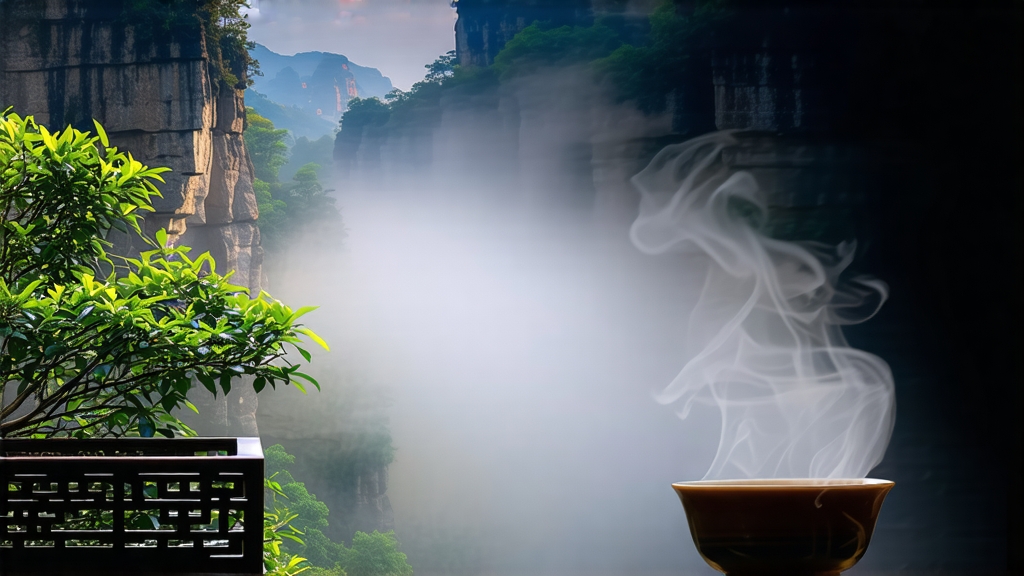
If green tea is China’s liquid spring and pu-erh its earthy archive, then Da Hong Pao sits somewhere between poetry and geology—a tea that carries the echo of Tang-dynasty monks, the sweat of Song-era charcoal masters, and the mineral heartbeat of Wuyi’s granite cliffs. Known in the West as “Big Red Robe,” this oolong is less a beverage than a cultural novella compressed into a leaf. To understand it is to step into a landscape where myth, imperial tribute, and modern auction records coexist, and where a single gram once sold for more than thirty times its weight in gold.
Origin Myth and Imperial Robes
Legend places Da Hong Pao’s birth during the Ming dynasty. A passing scholar, en route to the capital for imperial exams, fell ill in the Wuyi Mountains. Monks from the Tianxin Temple brewed leaves picked from nearby bushes; the scholar revived, passed the exams with top honors, and returned in gratitude, draping his own crimson imperial robe over the four mother bushes. Whether apocryphal or not, the story cemented the tea’s name and its aura of sanctity. Those original six bushes still cling to a narrow ledge of Jiulongke (“Nine-Dragon Nest”), their reddish bark visible against grey schist. Since 2006 picking from them has been banned; they are now guarded like living national treasures, their genetic line preserved through grafting rather than plucking.
Terroir: When Granite Breathes
Wuyi’s “Danxia” landform—purple-red sandstone and conglomerate shaped by 100-million-year-old rivers—creates a terraced micro-climate. Daytime heat radiates from the rock at night, extending oxidation rhythms inside the leaf. Mist rising from the Jiuqu (“Nine-Bend”) River deposits trace iron and potassium that tighten the leaf’s cell walls, concentrating aromatic oils. Locals speak of “yan yun” or “rock rhyme,” a tactile finish that feels like licking wet stone, followed by a cooling menthol lift in the throat. No other oolong, not even the high-mountain Taiwanese cousins, can replicate this lithic terroir.
From Leaf to Coal: The Craft in Six Acts
- Picking: Only the middle three leaves are taken when the bud’s edge serrations turn slightly reddish—an indicator that internal polyphenols have shifted from bitterness to orchid-like aldehydes.
- Withering: Leaves are spread on bamboo screens set halfway inside mountain caves where humidity hovers at 78 %. The cave’s constant temperature (22 °C) allows a 15-hour slow wither, twice as long as lowland oolongs.
- Shaking: Every hour the leaves are tossed in rattan drums, bruising edges to invite oxidation while keeping the center green. Masters listen for a rustle that sounds “like silk tearing,” the cue to stop.
- Killing-Green: A 280 °C wok flash-cooks the leaf for 47 seconds—long enough to halt oxidation at 40 %, preserving the signature green core ringed by russet.
- Charcoal Roasting: The soul of Da Hong Pao. Using local hardwood charcoal from peach trees, craftsmen roast the tea in bamboo baskets lowered into ash pits. The first roast lasts eight hours at 120 °C; after a month of rest, a second roast at 100 °C for six hours; sometimes a third at 80 °C. Each cycle forces residual moisture to migrate outward, carrying with it grassy volatiles and binding caramelized sugars to the leaf surface.
- Aging: Unlike green tea, Da Hong Pao improves for up to thirty years if stored in unglazed clay jars breathing through a parchment lid. Over decades, roast fire recedes and the “rock rhyme” deepens into notes of dried longan, sandalwood, and petrichor.
Grades and Market Reality
Authentic “mother-tree” Da Hong Pao exists only in government vaults, but three legitimate lineages circulate:
- Beidou (Big-Dipper): Grafted directly from cuttings of the original bushes; grown inside the 60 km² Wuyi core zone.
- Qidan (Scarlet Dawn): A separate clonal line identified through DNA fingerprinting; exhibits brighter floral top notes.
- Ruiquan (Auspicious Spring): A blended recipe of several Wuyi cultivars (often Rou Gui, Shui Xian, and Tieluohan) roasted to mimic mother-tree depth